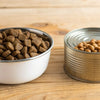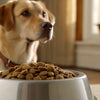How to Make Dogs Eat Their Dry Food: Tips for Picky Eaters
- Houndsy
Table of Contents
- Introduction
- Understanding Why Dogs Won't Eat Dry Food
- Tips for Encouraging Your Dog to Eat Dry Food
- Conclusion
- FAQs
Introduction
Have you ever watched your dog sniff at their bowl of dry food, only to turn away in disgust? You're not alone. Studies show that up to 30% of dog owners report feeding challenges with their furry friends. As devoted pet parents, we want the best for our dogs, including a balanced diet that keeps them healthy and happy. However, understanding how to make dogs eat their dry food can sometimes feel like a daunting task.
In this blog post, we will explore the various reasons why dogs might refuse to eat their dry food and offer practical strategies to encourage them to chow down. We’ll dive into topics ranging from behavioral triggers to the importance of food quality, and how our flagship product, the Houndsy Kibble Dispenser, can play a crucial role in revolutionizing your dog’s feeding experience. By the end of this article, you’ll have actionable insights to enhance your dog’s mealtime routine, ensuring they enjoy every bite.
So, let’s embark on this journey together to create a positive and enjoyable feeding experience for our beloved pets!
Understanding Why Dogs Won't Eat Dry Food
Common Reasons for Refusal
When our dogs turn their noses up at their kibble, it's essential to understand the underlying causes. Here are some of the most common reasons dogs might refuse to eat their dry food:
- Health Issues: Dental pain, gastrointestinal problems, and other health concerns can make eating uncomfortable for dogs. If your dog suddenly stops eating, it's crucial to consult your veterinarian to rule out any serious health issues.
- Food Quality: The quality and freshness of the food play a significant role in a dog's willingness to eat. Expired or low-quality kibble can turn off even the most enthusiastic eaters.
- Boredom or Kibble Fatigue: Just like humans, dogs can get bored of eating the same thing daily. This phenomenon, often referred to as "kibble fatigue," can lead to decreased appetite.
- Environmental Factors: The feeding environment matters. Distractions, noise, or a busy household can make it difficult for dogs to focus on their meals.
- Behavioral Issues: Some dogs may develop picky eating habits due to past experiences, such as being spoiled with table scraps or receiving too many treats.
By identifying the reasons behind your dog’s refusal to eat, we can tailor our approach to encourage them to enjoy their dry food once again.
Signs Your Dog Might Have a Health Issue
Before implementing any solutions, it's vital to be aware of potential health issues. Here are some signs that your dog might need a vet visit:
- Sudden loss of appetite
- Vomiting or diarrhea
- Excessive drooling or pawing at the mouth
- Unusual lethargy or changes in behavior
- Weight loss or gain
If you notice any of these signs, please consult your veterinarian for a thorough examination.
Tips for Encouraging Your Dog to Eat Dry Food
1. Assess and Enhance Food Quality
First and foremost, ensure that the food you're providing is high quality and fresh. Look for natural ingredients and avoid fillers like corn and soy. If your dog’s kibble has been sitting around for too long, it may have lost its appeal.
Action Step: Always check the expiration date on your dog’s food. If it’s past its prime, it’s time for a fresh bag!
2. Experiment with Food Toppers
Adding toppers can make dry food much more enticing. Toppers can range from a small amount of low-sodium chicken broth to fruits and vegetables that are safe for dogs, like carrots and blueberries.
Recommended Toppers:
- Plain, unsweetened yogurt
- Canned pumpkin (not the spiced pie filling)
- Cooked, unseasoned chicken or turkey
- Low-sodium broth
These additions not only enhance flavor but also provide extra nutrients. It’s a great way to make meals feel special for your pup.
3. Create a Positive Feeding Environment
Consider where you're feeding your dog. If their bowl is in a busy area, they may feel anxious or distracted. Find a quiet, comfortable spot where they can focus on their meal.
Action Step: Try setting up a designated feeding area that’s quiet and peaceful.
4. Maintain a Consistent Feeding Schedule
Dogs thrive on routine. Establishing a consistent feeding schedule helps them know when to expect meals, which can stimulate their appetite.
Action Step: Feed your dog at the same times every day, and avoid leaving food out for extended periods. If they don’t eat within 20-30 minutes, remove the bowl and try again at the next scheduled meal.
5. Consider Food Texture
Some dogs prefer wet food over dry kibble, especially if they have dental issues. You can try mixing wet food with dry kibble to create a more appealing texture.
Action Step: If your dog continues to refuse dry food, consider alternating between dry and wet food to see which they prefer.
6. Use the Gentle Starvation Method
If your dog is simply being picky, the gentle starvation method can help. This involves leaving the food out for a limited time and then removing it if they don’t eat.
Action Step: Offer the food for 30 minutes, then take it away. This method can help teach your dog that mealtime is important and that they need to eat when food is available.
7. Invest in a High-Quality Food Dispenser
Utilizing a high-quality food dispenser, like the Houndsy Kibble Dispenser, can enhance your dog’s feeding experience. This stylish dispenser not only keeps kibble fresh with its BPA-free liner but also offers perfect portion control and a convenient crank at standing height, eliminating the need to bend down during feeding time.
Why Houndsy?:
- Large storage capacity of 25-30 lbs
- Ergonomic design for easy dispensing
- Auto-locking mechanism to prevent accidental dispensing
By incorporating the Houndsy Kibble Dispenser into your routine, you can create a visually appealing and functional feeding environment that encourages your dog to eat.
8. Increase Exercise and Playtime
Physical activity can stimulate your dog’s appetite. Regular exercise helps ensure they are hungry and ready to eat at mealtime.
Action Step: Incorporate daily walks or playtime into your routine to keep your dog active and engaged.
Conclusion
Making sure our dogs eat their dry food is a common concern for pet parents, but with the right strategies, we can encourage healthy eating habits. By understanding the reasons behind their refusal, enhancing the food quality, and creating a positive feeding environment, we can transform mealtime into a pleasant experience for both dogs and their owners.
Remember, the Houndsy Kibble Dispenser can play a pivotal role in elevating your dog’s feeding routine, combining design excellence with functionality. With its innovative features, it simplifies the feeding process while ensuring your dog enjoys every bite.
If you have any tips or experiences to share about how to make dogs eat their dry food, we’d love to hear from you! Let’s create a community of informed pet parents dedicated to enhancing the feeding experience for our furry friends.
FAQs
Why won’t my dog eat their dry food?
There are various reasons, including health issues, food quality, boredom, or environmental factors. It's essential to assess these areas before implementing changes.
How can I tell if my dog’s refusal to eat is a health issue?
Signs include sudden appetite loss, vomiting, lethargy, or changes in behavior. If you notice these symptoms, consult your veterinarian promptly.
What is the gentle starvation method?
This method involves placing the food down for a limited time (30 minutes). If the dog does not eat, the food is removed and offered again at the next scheduled feeding time.
How can I make dry food more appealing?
Consider adding safe toppers like plain yogurt, canned pumpkin, or low-sodium chicken broth to enhance the flavor and texture of the dry food.
What role does the Houndsy Kibble Dispenser play in this process?
The Houndsy Kibble Dispenser simplifies feeding by providing perfect portion control, keeping food fresh, and offering an ergonomic way to feed your dog, encouraging them to enjoy their meals.
For more information on the Houndsy Kibble Dispenser, check out our product page here.












